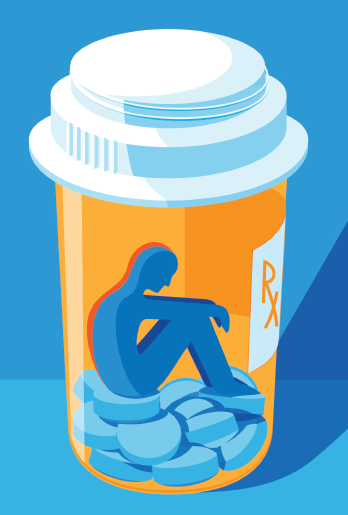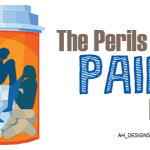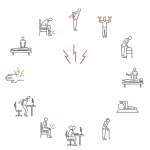
ah_designs / shutterstock.com
A 67-year-old man with a recent onset of diffuse muscular pain and stiffness and an erythrocyte sedimentation rate of 55 is referred to you by his family practitioner. He has a history of non-insulin-dependent diabetes mellitus, but no history of headaches or swollen joints. He has chronic back pain, has had two surgeries and was told that additional surgery would not be helpful. He takes 7.5 mg hydrocodone three times daily prescribed by his family physician for the back pain and is reasonably comfortable.
On examination, you find tenderness of the proximal muscles, no tenderness of the temporal arteries and no objective synovitis. He tests negative for rheumatoid factor, anti-CCP antibodies and antinuclear antibodies.
You diagnose polymyalgia rheumatica (PMR), which is confirmed by a dramatic and complete response to 20 mg daily of prednisone. His back pain does not improve. A year later, he requires 5–7.5 mg of prednisone to control the PMR symptoms and keep the sedimentation rate normal. The primary physician maintains good control of his diabetes, which is affected by the steroids.
He comes to see you for a routine visit and tells you he has a new primary care provider. According to the patient, his provider advised him that she is unable to prescribe any more narcotic analgesics, and they should, instead, be prescribed by his rheumatologist—you.
Discussion
With the present concerns about opioid abuse and overdose deaths, many government agencies and medical organizations have taken steps to limit the use of opioids, even in situations in which they were thought to be appropriate and almost mandatory a few years ago. In the case of chronic use of narcotics for non-cancer pain, restrictions include limitations on the quantity of drugs prescribed and refills, and hand-written prescriptions and frequent face-to-face contacts are needed.1,2 In Illinois, it is now mandatory that I check with the state’s drug registry before any first prescription. As of May 2016, 16 other states had such a requirement. Illinois does not yet tell me what I must do with the information I obtain from the registry.
Several organizations have published guidelines for chronic opioid use.1,2 These guidelines allow for the use of chronic opioids in selected cases, but generally recommend a contract with the patient. Periodic urine drug tests are recommended for all patients or for those with risk factors for abuse.1,2 It is generally accepted that abrupt discontinuation of chronic opioids is inappropriate and even dangerous. Various tapering regimens have been proposed, with only moderate success reported.3 Many of these employ such techniques as cognitive behavioral therapy and multidisciplinary management, resources that are not readily available to the practitioner and may not be acceptable to the patient because of financial and time considerations.
Because of these difficulties in prescribing chronic opioids and, perhaps, because of a real concern about their societal impact, many primary care providers have become reluctant to continue their patients’ prescriptions. I suspect, without proof, that this reluctance is greater among mid-level practitioners who now provide a large part of primary care. They are turning to the specialist, including the rheumatologist, to take on this task.
What is your ethical obligation to the patient in the scenario presented? Based on a strict interpretation of responsibility, it seems the new primary care physician has taken on the medical management provided by the previous provider. It is then up to her to continue the hydrocodone, taper it or refer to a pain management specialist. When you accepted this patient into your practice, it was for treatment of his systemic inflammatory disease, not the chronic degenerative problems.
Based on what is best for the patient, you would take responsibility for the hydrocodone prescriptions. You probably have more experience and comfort in managing chronic back pain, although perhaps with no more success, than the family practitioner and have an ongoing, trusting relationship with the patient.
Based on the need to provide expert care to more patients with complex rheumatic diseases, you could choose to decline this task, which can be handled adequately by others. One option would be to contact the primary care provider. A conversation could resolve the situation, but you may be advised the practitioner or her organization has a policy against chronic narcotic prescriptions. In one similar situation, I was told an organization did not allow its physicians to prescribe narcotics; when I checked with this organization, I found the restriction was much less rigid than I was led to believe. Other organizations allow prescribing of opioids but insist their physicians follow the Centers for Disease Control and Prevention (CDC) suggestions for pain contracts and drug testing.
Recommendations
Present recommendations for chronic opioid use in nonmalignant pain include starting with the lowest effective dose of short-acting opioids. Dosing should be increased only gradually to reach pre-
established goals, and the patient should be followed regularly to assess whether the goals of treatment have been reached and whether the pain medication is providing enough benefit to justify the long-term risk, such as opioid abuse. The patient should also be screened for risk factors for opioid abuse. Guidelines recommend a pain contract and periodic urine drug screening.1,2
If the dose of narcotic prescribed was excessive or the indication inappropriate, for example for fibromyalgia, a plan for reduction or discontinuation should be discussed with the patient.
In the case described above, I would prescribe the hydrocodone for now. The dose is not excessive, the patient has documented pathology, there is no evidence of abuse, and I will be seeing the patient regularly to follow his PMR. However, I would suggest to the patient that we should gradually reduce the dose of opioids. An unanswered question is what will happen when the patient’s PMR has resolved, he is off steroids, and he no longer needs a rheumatologist.
As a rheumatologist, you have the option, but not the obligation, to take over the opioid management that you did not initiate with the patient. Most people are now very aware of the societal problem of narcotic overuse, dependence and overdose, and of the restrictions placed on medical professionals regarding use of narcotics. It is usually possible to discuss these issues with patients in a nonjudgmental and non-argumentative fashion.
Edward P. Rose, MD, is a rheumatologist in solo practice in Belleville, Ill. He is a member of the ACR Committee on Ethics. He can be reached via email.
Acknowledgment: The author acknowledges and thanks Dr. Jane Kang for her review of and advice on this article.
References
- Dowell D, Haegerich TM, Chou R. CDC’s guideline for prescribing opioids for chronic pain—United States 2016. MMWR. 2016 Mar 18;65(1):1–49.
- European Pain Federation position paper on appropriate opioid use in chronic pain management. Eur J Pain. 2017 Jan;21(1):3–19.
- Frank JW, et al. Patient outcomes in dose reduction of discontinuation of long-term opioid therapy. Ann Int Med. 2017 Aug 1;267(3):181–191.
Do you have an ethical dilemma you’d like to see discussed in this forum? Contact us via email.


